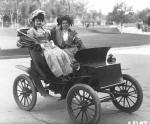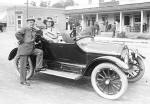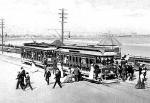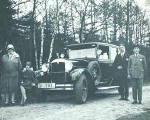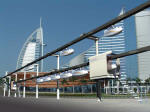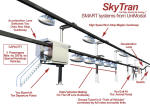|
March 10, 2006 was a deadline to submit comments to the Federal
Transportation Administration (FTA) Small Starts
program. I didn't have time
to mess with it, so started rambling. Made that deadline and realized
this was what I wanted to explain to people in this section of the SkyTran
website.
Comments from Doug Malewicki,
engineer/inventor:
What kinds of questions should we ask? Are there any solutions
that make sense?
Can existing transit be improved by integrating a
bunch of newer proven technologies into something more useful than now
proposed?
First ask what is the meaning of the word transit? What is implied
when that word pops into people’s minds? My simple definition is that
transit is equipment or machines that moves people and cargo to wherever
they want to go.
Next, ask what are some of the technologies that have
arisen in the last 50, 25, 10 and 5 years that can move people and
cargo around faster; safer; use less energy; pollute less; cost less to
build, operate, maintain; and lower daily user costs to the people
traveling on these systems?
Ask
what technologies are fairly new and may
have a place in an innovative transit system?
#1 - Computers
Faster, cheaper and smaller every year.
#2 - Automation
As widely used in factories since 1995.
#3 - Low cost sensing and control systems
Wow - consider how many thin-shelled, optimized structures
such as aluminum cans of Coca-Cola are filled, then sealed,
then organized into packages, then into eventual pallets each minute. This
process is all automatic and near perfect. These
profitable companies cannot waste money with production machine
stoppages, so have worked hard to perfect operations of many steps
into a flowing system. Amazing.
#4 - Electronics
Just like computers – always faster, cheaper and
smaller.
#5 - Magnets
Ever stronger; still waiting for room temperature super
conductors.
#6 - Communications
Cable, satellite, internets, cell phones, fiber
optics, Radio Frequency IDentification (RFID tags).
#7 - Electrical power storage
Battery energy density and power
density keep improving. World’s fastest electric car record is 350
mph at the Bonneville salt flats.
#8 - Light weight advanced composites
Abounding in high strength, low
mass structural applications such as sports equipment, aircraft, race
cars, space ships, etc.
#9 - Ergonomics
Was this word even around 50 years ago? It
includes studies of ingress and egress into any type of vehicle and
overall human comfort.
#10 - Optimized aerodynamics: For minimum energy consumption at speed; we
have learned a lot since the birth of aviation in 1903.
#11 - Renewable energy: Wind, hydroelectric, tidal, wave, biomass, solar, geothermal,
ocean thermal. Sweden recently announced their plan to do whatever
it takes technically and politically to be independent of fossil fuels by
2020.
#12 - Human safety during transit
From the Sunday March 4, 2006 PARADE
news magazine – “Since the start of the
Revolution in 1775, about a million Americans have died in wars. And
since Henry Ford introduced the mass-produced motorcar in 1913, more than
2.5 million Americans have met their death on the roads."
Appalling! Humans have created many imperfect
machines that are operated by those same imperfect humans to satisfy their
innate, never ending quest for farther ranging, faster mobility. Fortunately,
technology now exists to nearly eliminate
travel related deaths.
READ how engineers work hard to make automobiles safer.
|
Automobile
Structural Integrity
If nothing else, I have learned from Robosaurus, my car-crunching,
CAR-nivorous, fire-breathing monster robot patented invention that
we are are all driving around in flimsy sheet metal structural
envelopes that squish quite easily. Cars look solid, shiny
and beefy, but they aren't! See:
www.canosoarus.com/02Robosaurus/Robo01.htm |

Robosaurus tears a car in half!
|
Robosaurus says
"Bye, bye Herbie!" |
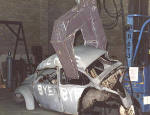
An early claw test. |
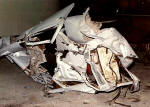
The final result of some more than affectionate hydraulic
squeezing. |
|
Benefits of a 250 Mile Per Gallon
Automobile
Hate to say it, but even if 250 MPG was commercially feasible, such
a super efficient internal combustion, hybrid or non-fossil fuel
car would do absolutely zero to reduce rush hour
congestion. However, SkyTran can eliminate all commuting
congestion because it uses a) automated close 1/2 second
vehicle-to-vehicle spacing intervals and b) 3-dimensions instead of
2. |

Malewicki holds two official Guinness World Record for driving his
California Commuter. |

157 MPG for his 451 mile LA to SF record run.
Way back in 1980! |

A more streamlined version of the 26 year old record
holder exists today. |

This new version will achieve 225 MPG at freeway speeds. |
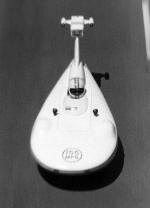 |
The street and freeway legal, one passenger California Commuter
achieved 155 MPG at freeway speeds because of its small frontal
area, streamlined teardrop shape and very light weight.
(www.canosoarus.com/03CalifCommuter/CalCom01.htm)
These same engineering principles will be applied to SkyTran, though
not to those same extremes. |
|
| Safe
Tight Spacing Each SkyTran vehicle will make measurements and decisions
automatically, 1000 times per second. Computers work with
control and sensing systems, just like in today's factories! |
Transport
Experts, Consultants, and City Politicians.
I have complained for years that today's politicians, who
greatly influence transit decisions, are not technically astute,
don't seem to care to learn, and refuse to attend factory automation
Trade Shows where they could start getting informed as to what is
going on in the ever changing world around them.
HERE are some good technical resources. |
Bringing together all of the above new technologies, and
then applying basic physics and mathematical analysis yields some amazing
conclusions that jump out at us! It becomes quite clear that using
small personalized, aerodynamic, electric MagLev vehicles on an elevated
guideway is far, far superior to light rail in all aspects - costs
(capital installation, operating, maintenance and user), hourly passenger
capacity, energy use, safety and travel time.
#1 - High Hourly Capacity
Surprisingly, contrary to intuition,
simple calculations show that a continuous stream of lightweight small
vehicles has a huge hourly passenger capacity. Obviously, that
doesn’t happen if you maintain the same vehicle spacing as used for light
rail (minutes), but it does happen at the spacing intervals more like
those used in factory automation mass production
processes (seconds).
#2 - Low Supporting Infrastructure Costs
Obviously, the
structures to support the weight of many humans spread over a mile is much less than that same weight concentrated in several hundred feet of a single train. Wow - 1/100th of the weight per
foot allows all structure and respective structural support costs to go
down, way down.
#3 - Off-line Stations Means Non-stop Commuting
If you spend time to figure
out how to put all stations off-line, then small vehicles can be operated non-stop on the main guideway at
steady high
speeds, if the guideway never gets fully saturated. This
can be controlled automatically. Simple, though ruthless, extremely
precise computer decisions.
#4 - Low Cost Stations Yields Ubiquitous Stations
If you make stations
simple and elementary, more like bus stops rather than $7 million
edifices, you can afford to place many more along any route for the
benefit of the passengers. If they are all off-line, installing lots of
mini-stations will not affect non-stop through speeds.
#5 - Personalized Vehicles Mean Never Having to Stop Enroute
If
vehicles are very small, meaning personalized, there will never be a need
to stop at any intermediate stations. None of your personal time will
ever be wasted decelerating, stopping letting some passengers
depart, new passengers board, then re-accelerating to cruise speed
as is typical with most group transit. Then repeat ad nauseam. Group
transit is from the dark ages when no automation was available and an
expensive human driver was absolutely required for any transit.
Human drivers rarely pay attention to traffic and their
driving tasks 100% of the time (causes crashes). Computers can pay
full attention always to traffic and driving and will never go
on strike for more wages, or need retirement benefits, health benefits, or lunch or potty breaks.
#6 - Mass Produced, Low Cost Small Vehicles Mean Extra Vehicles Can Be
Held Everywhere for YOUR Convenience
If
extra vehicles are waiting for you like taxi cabs at each station,
then passengers no longer need to think about scheduled arrival times
and making the bus or train ever again. Get in the next vehicle and go!
This saves even more travel time by eliminating the need to arrive early just to
ensure you don’t miss the scheduled vehicle.
#7 - Safety is Greatly Enhanced by Synchronized Speeds, Anti-collision Avoidance Radar and Restricting
All Travel to One Lane Only
Once a
vehicle is merged in and moving along on the high speed through
guideway, it will use the same radar and anti-collision sensors currently available on
luxury automobiles to precisely follow the vehicle ahead at a safe
distance. On multiple lane freeways, automobile radar systems can be
surprised by rude drivers cutting sharply in front of and surprising the sensors. Guideways
will be one lane only to
eliminate lane switcher caused crashes.
#8 - How Many People Have Died Since 1900 Because a Train or Trolley has
Derailed?
Traveling on rails means a chance of
derailing. Derailing cannot be eliminated and happens
every day, sometimes with huge loss of life. Why not get rid get rid of vehicles
that ride on wheels rolling on top of rails? Build a trapped system that
makes it impossible to derail. High school students could figure out
how to do that.
The
above are a few of the main principles for 21st century
advanced transit.
Your choice folks! |


